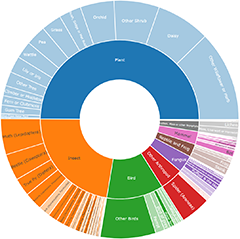Caps on stems; gills below caps [mushrooms or mushroom-like]
Almost all members of this group have the fleshy fruitbodies that are commonly called mushrooms. You also see them referred to as toadstools, but mushrooms will be the term used here. On the underside of the cap are the gills, extending in from the margin towards the stem. Usually gills come in a range of lengths, from very short to long and, in most species, the long gills reach the stem. If no gills reach the stem, the species is said to have free gills.
A universal veil is a membrane that envelopes the entire mushroom at the button stage and, as the stem expands, that veil is ruptured and may leave traces as a cup-like surround (volva) or ridges around the base of the stem or as irregular wats or flakes of tissue on the cap. A partial veil covers the gills in an immature mushroom (and is called a cortina if it has a flimsy, cobwebby appearance) and extends from the edge of the cap to the stem. As the cap expands, the partial veil breaks and may leave traces as a collar of tissue (a ring or annulus) around the stem or as wispy, hard to see filaments on the stem in the case of a cortina. In some genera both types of veil are present, in some only one type is present and in many neither is present. Veil remnants may erode away over time.
In fungal field guides you see the word agaric, a collective term for fleshy fruitbodies that have a cap with gills below. A mushroom is a stemmed agaric and there are also stemless agarics.
In the following hints you see examples of useful identification features and a few of the more commonly seen genera in which at least some species (not necessarily all) show these features. The lepiotoid genera are: Chlorophyllum, Lepiota, Leucoagaricus, Leucocoprinus, Macrolepiota.
Hints
Gills white: Amanita, Armillaria, Mycena, Russula, lepiotoid genera.
Gills faintly pink: Entoloma, Pluteus, Volvopluteus.
Gills rusty brown: Cortinarius, Gymnopilus.
Gills dark chocolate brown: Agaricus, Agrocybe.
Gills purplish-brown to black: Coprinus, Hypholoma, Leratiomyces, Panaeolus, Psilocybe, Stropharia.
With a volva (possibly buried): Amanita, Volvopluteus.
Stem with a ring: Agaricus, Agrocybe, Gymnopilus, lepiotoid genera.
With a cortina: Cortinarius, Gymnopilus, Hebeloma, Psilocybe.
With free gills: Agaricus, Amanita, Pluteus, Volvopluteus, lepiotoid genera.
Growing in dense clusters, all stems arising from the same point: Armillaria, Flammulina, Gymnopilus, Hypholoma, Mycena.
Mushroom bleeds when damaged: Lactarius s.l., Mycena.
Bright yellow gills that bruise blue-green: Phylloporus.
Leathery texture: Lentinus, Neolentinus.
Fresh mushroom snaps a bit like chalk: Lactarius s.l., Russula.
Stem short & well-off centre: Melanotus, Panellus.
The immature mushroom has a granular coating that is easily rubbed off and may disappear with age: Cystoderma, Cystolepiota, Leucocoprinus.
Cap with dark scales, in concentric rings, over a white base & with solid colour at the centre: several lepiotoid genera.
On twig/leaf litter: Marasmius, Mycena.
On herbivore dung: Coprinopsis, Panaeolus, Psilocybe, Stropharia.
Warnings
The mutual pressure of mushrooms that grow in dense clusters may produce some distorted fruitbodies with stems off-centre to some degree, but in species of Melanotus and Panellus the off-centre stem is normal.
Normally stemless agarics occasionally produce fruitbodies with very rudimentary stems. If your sighting has a very rudimentary stem you may need to check that group.
As a mushroom dries out, gills attached to the stem may tear away and seem free. If you look very closely (best with a 10x handlens) you would see ragged evidence of tearing, which you won’t see in free gills.
Announcements
There are currently no announcements.
Discussion
Unverified Cap on a stem; gills below cap [mushrooms or mushroom-like]
Psathyrella echinata grows on wood, hence my suggestion from your images. However after looking at your suggestion you may well be correct with Melanophyllum haematospermum but without spore prints and possible micro examination I hesitate to go further.
see https://data.rbg.vic.gov.au/dev/fungikeys/funkey/key/Funkey%20-%20Key%20to%20the%20Agarics%20of%20Australia/Media/Html/Fact%20Sheets/Melanophyllum_haematospermum.htm
Psathyrella echinata
Psathyrella echinata
Psathyrella echinata
Significant sightings
- Humidicutis arcohastata at QPRC LGA
- Lactarius turpis at QPRC LGA
- Pholiota highlandensis
- Xeromphalina sp. at Wattamolla, NSW
- Mycena mulawaestris at Wattamolla, NSW
- Humidicutis helicoides at Wattamolla, NSW
- Marasmiellus candidus at Quaama, NSW
- Panaeolus sp. at Quaama, NSW
- Amanita marmorata at Moruya, NSW
- Psathyrella echinata at Uriarra Village, ACT
Top contributors
- trevorpreston 702
- Teresa 335
- AlisonMilton 297
- KenT 230
- LisaH 197
- TimL 194
- Csteele4 184
- AaronClausen 132
- KylieWaldon 120
- VanessaC 119
Top moderators
- Heino1 2.2K
- Heinol 838
- Heino 392
- Teresa 376
- Csteele4 346
- Pam 323
- KenT 218
- MichaelMulvaney 136
- JTran 73
- CanberraFungiGroup 43



![Unverified Cap on a stem; gills below cap [mushrooms or mushroom-like] at Kenny, ACT - 24 Sep 2025 by sbittinger Unverified Cap on a stem; gills below cap [mushrooms or mushroom-like] at Kenny, ACT - 24 Sep 2025 by sbittinger](https://api.naturemapr.org/api/sightings/4699999/images/1?width=300&height=300)
![Unverified Cap on a stem; gills below cap [mushrooms or mushroom-like] at O'Malley, ACT - 27 Sep 2025 by Mike Unverified Cap on a stem; gills below cap [mushrooms or mushroom-like] at O'Malley, ACT - 27 Sep 2025 by Mike](https://api.naturemapr.org/api/sightings/4699933/images/1?width=300&height=300)


![Unverified Cap on a stem; gills below cap [mushrooms or mushroom-like] at Morton Plains, VIC - 14 Jul 2011 by WendyEM Unverified Cap on a stem; gills below cap [mushrooms or mushroom-like] at Morton Plains, VIC - 14 Jul 2011 by WendyEM](https://api.naturemapr.org/api/sightings/4699183/images/1?width=300&height=300)
![Unverified Cap on a stem; gills below cap [mushrooms or mushroom-like] at Morton Plains, VIC - 29 Aug 2010 by WendyEM Unverified Cap on a stem; gills below cap [mushrooms or mushroom-like] at Morton Plains, VIC - 29 Aug 2010 by WendyEM](https://api.naturemapr.org/api/sightings/4699168/images/1?width=300&height=300)






![Unverified Cap on a stem; gills below cap [mushrooms or mushroom-like] at Acton, ACT - 21 Sep 2025 by Clarel Unverified Cap on a stem; gills below cap [mushrooms or mushroom-like] at Acton, ACT - 21 Sep 2025 by Clarel](https://api.naturemapr.org/api/sightings/4698907/images/1?width=300&height=300)


![Unverified Cap on a stem; gills below cap [mushrooms or mushroom-like] at Watson, ACT - 21 Sep 2025 by Lisa.Jok Unverified Cap on a stem; gills below cap [mushrooms or mushroom-like] at Watson, ACT - 21 Sep 2025 by Lisa.Jok](https://api.naturemapr.org/api/sightings/4698663/images/1?width=300&height=300)


![Unverified Cap on a stem; gills below cap [mushrooms or mushroom-like] at Gherang, VIC - 13 Sep 2025 by WendyEM Unverified Cap on a stem; gills below cap [mushrooms or mushroom-like] at Gherang, VIC - 13 Sep 2025 by WendyEM](https://api.naturemapr.org/api/sightings/4697421/images/1?width=300&height=300)








![Unverified Cap on a stem; gills below cap [mushrooms or mushroom-like] by MazzV Unverified Cap on a stem; gills below cap [mushrooms or mushroom-like] by MazzV](https://api.naturemapr.org/api/sightings/4696066/images/1?width=300&height=300)
![Unverified Cap on a stem; gills below cap [mushrooms or mushroom-like] by MazzV Unverified Cap on a stem; gills below cap [mushrooms or mushroom-like] by MazzV](https://api.naturemapr.org/api/sightings/4696063/images/1?width=300&height=300)


![Unverified Cap on a stem; gills below cap [mushrooms or mushroom-like] by Paul4K Unverified Cap on a stem; gills below cap [mushrooms or mushroom-like] by Paul4K](https://api.naturemapr.org/api/sightings/4693463/images/1?width=300&height=300)

![Unverified Cap on a stem; gills below cap [mushrooms or mushroom-like] at Gundary, NSW - 3 Sep 2025 by trevorpreston Unverified Cap on a stem; gills below cap [mushrooms or mushroom-like] at Gundary, NSW - 3 Sep 2025 by trevorpreston](https://api.naturemapr.org/api/sightings/4693200/images/1?width=300&height=300)
![Unverified Cap on a stem; gills below cap [mushrooms or mushroom-like] at Wallagoot, NSW - 31 Aug 2025 by AlisonMilton Unverified Cap on a stem; gills below cap [mushrooms or mushroom-like] at Wallagoot, NSW - 31 Aug 2025 by AlisonMilton](https://api.naturemapr.org/api/sightings/4693114/images/1?width=300&height=300)

![Unverified Cap on a stem; gills below cap [mushrooms or mushroom-like] at Paddys River, ACT - 31 Aug 2025 by Clarel Unverified Cap on a stem; gills below cap [mushrooms or mushroom-like] at Paddys River, ACT - 31 Aug 2025 by Clarel](https://api.naturemapr.org/api/sightings/4692180/images/1?width=300&height=300)


![Unverified Cap on a stem; gills below cap [mushrooms or mushroom-like] at Paddys River, ACT - 31 Aug 2025 by Clarel Unverified Cap on a stem; gills below cap [mushrooms or mushroom-like] at Paddys River, ACT - 31 Aug 2025 by Clarel](https://api.naturemapr.org/api/sightings/4692172/images/1?width=300&height=300)



![Unverified Cap on a stem; gills below cap [mushrooms or mushroom-like] at Kingsdale, NSW - 1 Sep 2025 by trevorpreston Unverified Cap on a stem; gills below cap [mushrooms or mushroom-like] at Kingsdale, NSW - 1 Sep 2025 by trevorpreston](https://api.naturemapr.org/api/sightings/4692094/images/1?width=300&height=300)
![Unverified Cap on a stem; gills below cap [mushrooms or mushroom-like] at Freshwater Creek, VIC - 4 Jul 2025 by WendyEM Unverified Cap on a stem; gills below cap [mushrooms or mushroom-like] at Freshwater Creek, VIC - 4 Jul 2025 by WendyEM](https://api.naturemapr.org/api/sightings/4692024/images/1?width=300&height=300)

![Unverified Cap on a stem; gills below cap [mushrooms or mushroom-like] at Freshwater Creek, VIC - 9 Aug 2025 by WendyEM Unverified Cap on a stem; gills below cap [mushrooms or mushroom-like] at Freshwater Creek, VIC - 9 Aug 2025 by WendyEM](https://api.naturemapr.org/api/sightings/4692012/images/1?width=300&height=300)

